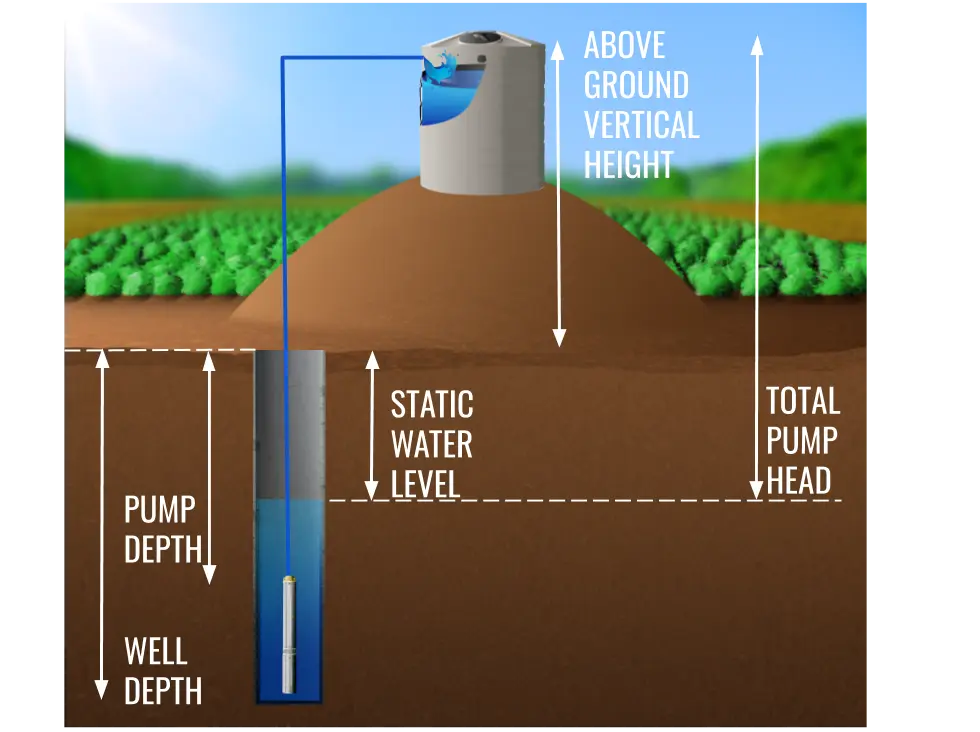Top 5 Ways to Measure Your Well’s Static Water Level
Top 5 Ways to Measure Static Water Level
1. Visually
2. Dropping a Rock & Measuring Fall Time
3. Fishing Line and Water Bottle
4. Tape Measure with Weight
5. Professional Well Measuring Device

One of the first steps in sizing either a solar well pump or a normal AC submersible pump is determining your water well’s static water level, also referred to as SWL. Static water level is the distance from the grounds surface to where the top of the water sits in the well. SWL (along with the volume of water needed) is important as it determines the pump required for your solar pump.
If you are not sure of your wells static water level, good news, it is really easy to measure, with materials you probably already have. Here are the 6 best ways to measure your wells static water level, and check out the video below showing how to make the various measurements.

Visually
One of the simplest ways to check the water level in your well is just to look down in the well casing to determine if you can see any water. In general, you can see the reflection of water up to around 50ft or so. Past that, even with a flashlight it can get difficult. If you can see water, there is a very good chance your water level is less than 50ft which is enough to size your solar pump system. Most of the time you can estimate the water level within 10ft or so.

Dropping a Rock and Measuring Fall Time
With this approach, you will measure the time it takes for a small rock or pebble to fall from the surface until you hear it splash in the water. A bit of warning, this method should be performed sparingly, as you don’t want to regularly drop even small rocks in your well. This should also not be performed when there is a submersible pump in the well due to the risk of the rock lodging between the pump and the well casing (unless your casing is really large).
Using a stopwatch (the one on your smart phone works great) drop the pebble and start the timer. When you hear the sound of the pebble hitting water, stop the timer. Multiply this number by 24 for an approximate measurement in feet. This is not the most accurate measurement method, but can usually get you to within 10-20 feet of knowing your static water level, which is usually good enough to size your solar pump.

Fishing Line and Water Bottle
Fill up a water bottle halfway with water and attach some fishing line to the bottle, make sure to tie the line off tight. You can do this by inserting the fishing line though the bottle’s lid, tying the line to a small stick and inserting it into the bottle. Drop the water bottle down into the well, waiting for the feeling of weightlessness (line to go slack), which means that the bottle has found the static water level and is floating on top of it. Mark the fishing line level with the well and haul the water bottle up. Measure from water bottle to the piece of marked fishing line to find static water level.

Tape Measure with Weight
Any type of weight will do here, a nut or bolt tied off on the tape measure to provide some weight on the end. Watch the video to see how we made one with an eye bolt, large washer and two nuts. You will be able to both feel and hear when the weight hits the water. This method is also useful, if you need to check the total well depth. Usually you can feel when the weight hits the bottom of the well to get your total depth!

Professional Well Measuring Device
If you are going to be measuring wells on a regular basis, you might want to invest in a professional well measuring device. These devices feature a metal probe attached to a measuring tape. They put out a small electrical current, which can detect being submerged in water. When the probe is submerged, the unit emits a loud beep and the static water level can be read on the measuring tape. Even better, they can also be used to measure total well depth.
These units come in various lengths, from 100ft up to 1000ft+. The large units even come with an electrical motor to save your arms from hauling up and down the measuring tape, making the process fast and easy. The down side is prices start at $500 and go up from there, but they are well worth the money if you are measuring wells on a regular basis.
Need Help Finding Your Well Log? We’ve compiled a list of well log databases by state, if your state doesn’t have a link or you aren’t able to find you well log with one of these databases, contact your local county office and they may have the well log on file.
Stuck on figuring out the next step? Contact one of our pump specialists by calling 888-637-4493
